by Lisa Cooke | Dec 5, 2016 | 01 What's New, Research Skills, Travel
We love the ease with which we can search online, but a genealogy research trip can offer exceptional and unique rewards. If you have been apprehensive about visiting a courthouse or archive, follow our 4 step plan for a successful genealogy research trip that could lead to your own amazing discovery!
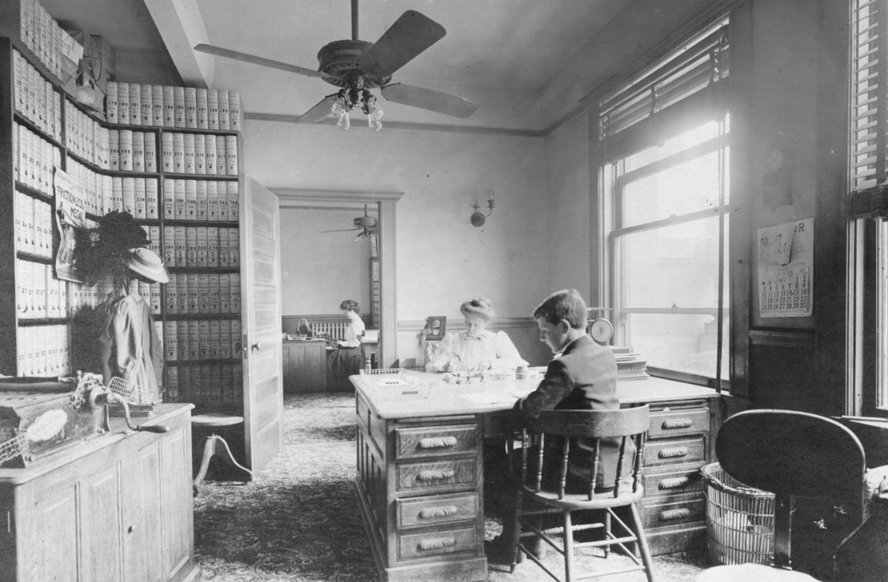
By J. D. Cress [Public domain], via Wikimedia Commons
In my genealogy world, if an answer can’t be found on one of my favorite genealogy website repositories (like FamilySearch, Ancestry, or Findmypast) then a quick Google search usually does the trick.
However, we new genealogists of the Internet era may be banking on the fact that “everything” we need is online. This is obviously not true. In fact, many local libraries and archives are under-staffed and under-funded making digitizing of their holdings difficult. This is why making a genealogy research trip is a really good idea.
The Unprepared Genealogy Research Trip
Several years ago, I made my first research trip. I was woefully unprepared. On a whim, I drove three hours on a weekday to “go to the courthouse.” I arrived at lunch time…and it was closed for an hour. Sigh. However, a nice receptionist sugg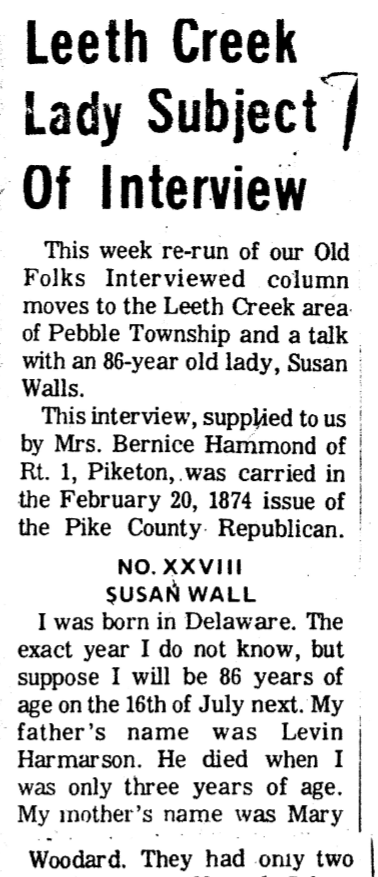 ested I go to the local public library just down the street.
ested I go to the local public library just down the street.
When I arrived at the tiny corner building, I asked at the circulation desk for the history department. She seemed a little taken back, but said, “We have a little room in the basement with some local history and genealogy things.” Note to self: not all libraries are large enough for a “history department.”
In the basement room, no one was on duty, but a nicely printed instruction sheet of what was available and how to use their files laid on the table. “I guess I just dig in,” I thought, and off I went.
Though this was my first genealogy research trip, it proved to be very fruitful. In a scrapbook simply titled “Walls Family,” I found a Xerox
copy of an article from an 1874 newspaper. In this article, my fourth great-grandmother (Susannah Harmarson Walls) had been interviewed because she was the oldest living woman in the township. Her interview began, “I was born in Delaware. The exact year, I do not know, but I suppose I will be 86 years of age on the 16th of July next. My father’s name was Levin Harmarson. He died when I was only three years of age. My mother’s name was Mary Woodard.”
The interview included the story of her mother re-marrying, the family leaving Delaware for Wheeling, Virginia, and she marrying her step-brother there. Then, they traveled on into Scioto County, Ohio. She named each of her eleven children and their spouses.
The information in this one interview was particularly helpful. Before this, we had no idea when or where Susannah and Levi married, and finding the spouses of their children had proved difficult!
Though this was an amazing find, I wonder what other records, items, or photographs I might have dug up had I prepared ahead of time. Perhaps, I would have had time to dig more into their microfilm holdings, archived pictures, atlases, or even had time to go to the local cemetery.
The Prepared Genealogy Research Trip
Fast forward several years and I am making much more prepared genealogy research trips. Get the most from your next genealogy research trip by following these 4 important steps:
1. Run a Narrative Report. Start creating your genealogy research trip plan by printing out a narrative report of your targeted family line. This can be done with the reports feature found in genealogy database programs like RootsMagic.
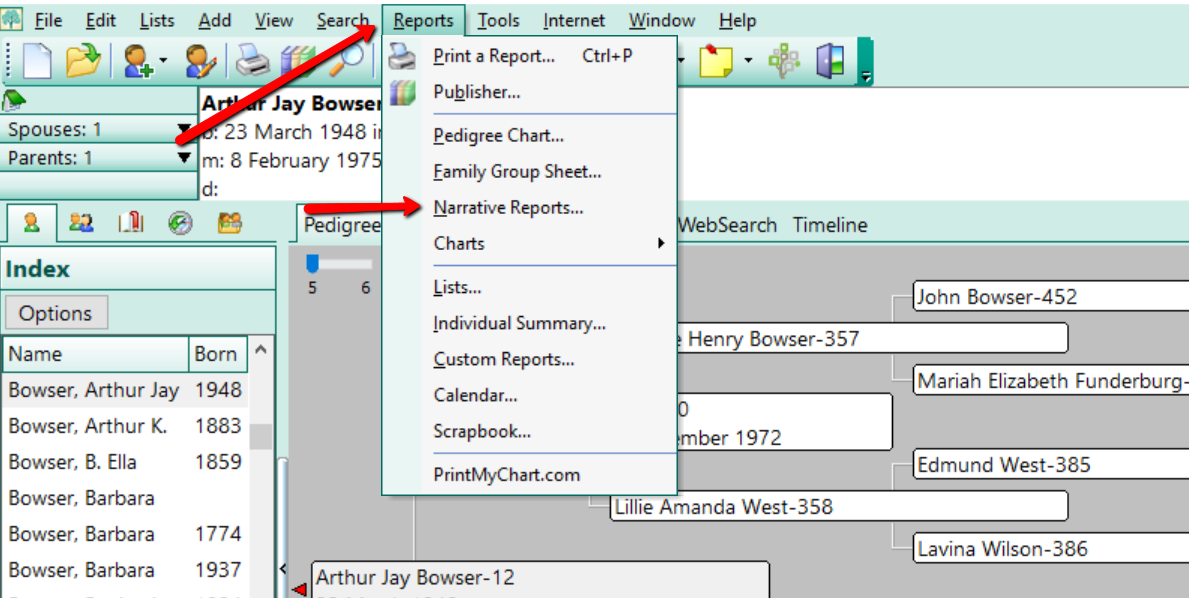
2. Look for holes in your research. Carefully read through the report looking for holes in your research or where you may be missing a source. In this case, a “hole in your research,” may be the missing marriage date of a couple, or the missing birth date of a child. Circle these “holes” and make a list of what the needed piece of information is to correct it and where you can find it.
Example: Clark County, Ohio. Need a death date for Edmund West. County didn’t keep death records that early. Likely died between 1830-1840. Check probate record books, estate files, tax records, cemetery records, and tombstones at Wilson Cemetery.
Maybe you have a birth date, but no source. A source is the proof of a particular fact. For example, a good source for a birth date is a birth register or even a marriage record. If you are lacking sources for your genealogy facts or are not sure how to begin sourcing your genealogy, learn more about that here.
3. Decide what repositories you will need to visit. After creating your list, determine where these items are held by asking yourself important questions, such as: Will I need to visit the courthouse, a library, an archive, cemetery, or all the above? Which location will produce the most results? Should I visit the archives first, or the courthouse?
4. Contact each repository ahead of time. Finding out the days and times when each of these places is open before you go is a must! Try to pick a day when all, or most, of the places are open so that you can get a lot done. If this isn’t possible, consider making an extended stay overnight to accomplish your goals.
Keep in mind that not all websites are up-to-date. Just because the library says it is open from 10 to 5 every day but Sunday on the webpage doesn’t necessarily mean that is still the case. Always call each establishment to verify days and hours of operation.
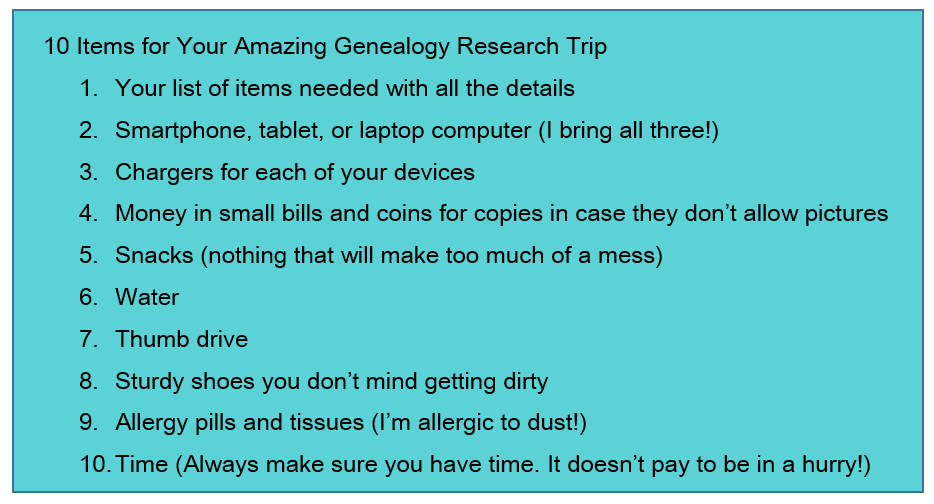
Remember, there are newspapers, maps, documents, and pictures just waiting to be uncovered. By thinking about what you want to achieve while on your trip and what information you need to find and where, your genealogy research trip can be a successful one. Happy hunting!
More on Genealogy Research Trips
Still feeling unmotivated to get on the road, read or listen to these features for inspiring tips to make a courthouse records research trip in your near future!
Courthouse Records Research Trip
Premium Podcast Episode 126 – Road Trips for Genealogy
Premium Video – Using Evernote to Create a Genealogy Research Plan
by Lisa Cooke | Nov 13, 2017 | 01 What's New, Military, United States
Compiled Military Service Records are core genealogical documents for your ancestors’ military service for the Revolutionary War, War of 1812, Indian Wars, Mexican Wars, Civil War, and the Spanish-American War. Expert Michael Strauss tells us what’s in them and how to find them.

What’s in Compiled Military Service Records
Compiled Military Service Records (often abbreviated as CMSR or CSR) are the records that may exist for your ancestors who served in the U.S. military from the Revolutionary War to the end of the Philippine Insurrection and Spanish-American War. This set of records represents the volunteer Army and doesn’t include regular Army enlistments. Except for limited records of the Revolutionary War and the War of 1812 for the Navy, the other branches of the military (including Navy, Marines, and Revenue Cutter Service) all have their equivalent set of records.
Information you may find in Compiled Military Service Records varies greatly from each of the war periods. They typically contain:
- name, unit, and period of service of the veteran
- muster in/out information
- rank in/out details
- details of the soldier’s career: promotions, prisoner of war memorandums, casualties, and a number of personnel papers which may include enlistment papers and other related documents
- for several of the war periods, physical descriptions of the soldiers including name, age, nativity, occupation, height, hair, eyes, and complexion information
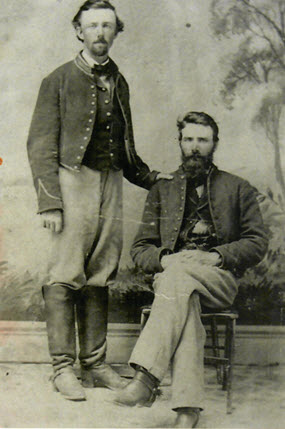
John H Lemaster. Photo courtesy of Michael Strauss.
Your ancestor may have multiple entries in Compiled Military Service Records. This could occur if a soldier served in more than one unit, or in the case of John LeMaster, if he enlisted in two different armies during the Civil War! The Civil War divided our nation, testing the loyalty of all persons who lived during this time. Lemaster chose the Confederacy, at least initially, when he enlisted with the 2nd VA Infantry in 1861 in Charlestown, VA. He fought alongside his Brigade commander, Thomas J. Jackson, who later would be known as “Stonewall Jackson.”
After the Confederate loss at the battle of Gettysburg, he deserted and lived in Martinsburg in what was now West Virginia, where on his draft registration he was listed as a deserter from the Rebel Army. In 1864, he enlisted in the United States Army with the 3rd WV Cavalry, serving out the duration of the war until 1865. After the war, he was granted a federal pension, with no mention of his former service in the Confederacy.
Here are his military service records for both the Confederate and Union armies:
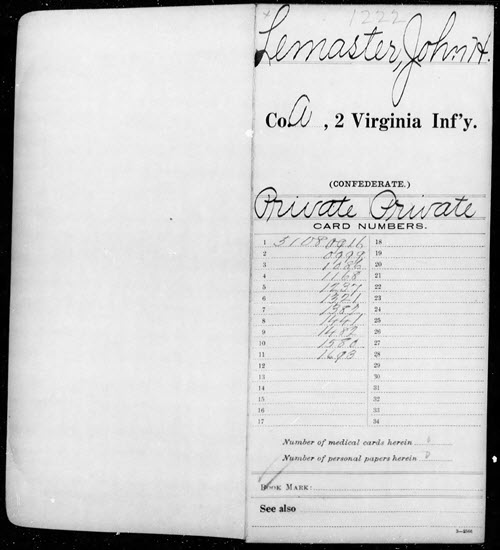
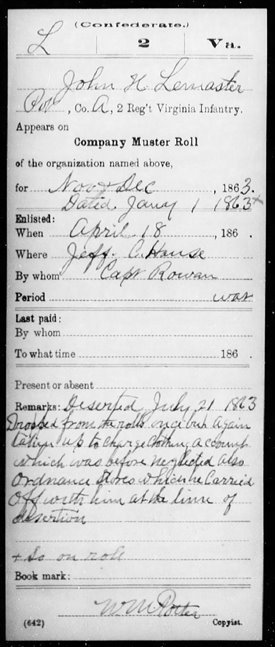
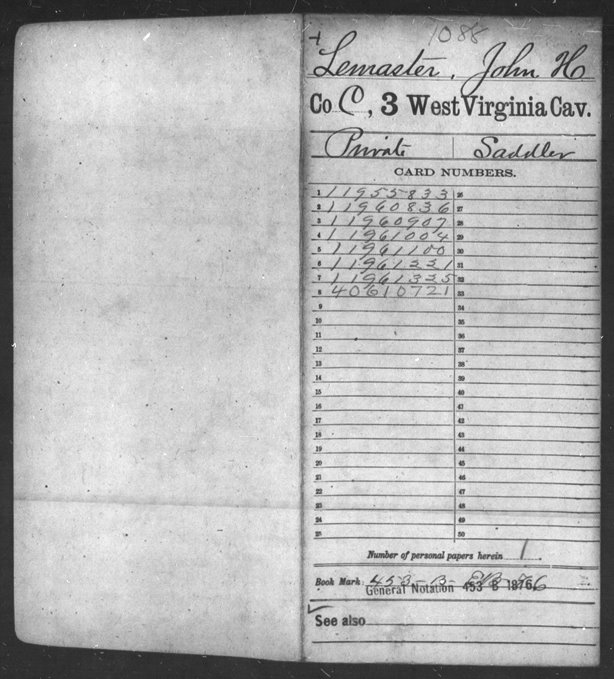
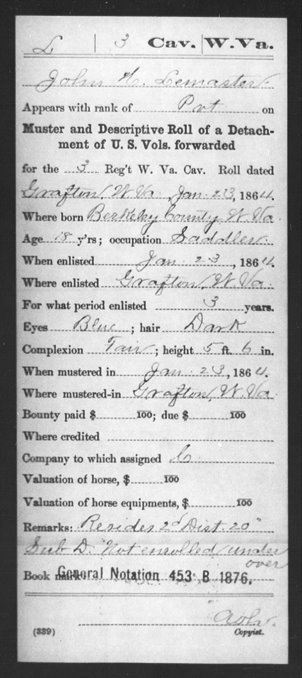
Where to Find Compiled Military Service Records
You may access various CMSR indexes and images online. Here are links to collections at subscription websites Fold3, Ancestry.com and even a couple at the free FamilySearch.org:
Compiled Military Service Records at fold3:
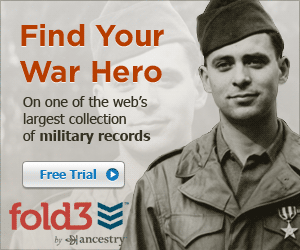 Revolutionary War. Compiled Military Service Record images for CT, DE, GA, MD, MA, NH, NJ, NY, NC, PA, RI, SC, VT, VA, and Continental Troops. Genealogists should also search the local state where their ancestors were from as some Militia isn’t included in these records. During the Revolutionary War additional Compiled Service Records were completed for the Navy, which was broken down to include Naval Personnel, Quartermaster General, and Commissary General Departments. One additional set of CMSR images covered Revolutionary War service along with Imprisonment Cards.
Revolutionary War. Compiled Military Service Record images for CT, DE, GA, MD, MA, NH, NJ, NY, NC, PA, RI, SC, VT, VA, and Continental Troops. Genealogists should also search the local state where their ancestors were from as some Militia isn’t included in these records. During the Revolutionary War additional Compiled Service Records were completed for the Navy, which was broken down to include Naval Personnel, Quartermaster General, and Commissary General Departments. One additional set of CMSR images covered Revolutionary War service along with Imprisonment Cards.- Old Wars (1784-1811). After the Revolutionary War, the newly formed United States government sought to maintain a regular Army. However, volunteer soldiers who served from 1784-1811 were recorded. (One of the reasons for volunteers to be called up would have included the Whiskey Rebellion of 1793.) Their Compiled Military Service Record full images are available here.
- War of 1812. Compiled Military Service Records Indexes for CT, DE, DC, GA, IL, IN, KY, LA, MD, MA, MI, MS, MO, NH, NJ, NY, NC, OH, PA, RI, SC, TN, VT, VA and also the Cherokee, Chickasaw, Choctaw, Creek, and Shawanoe Indians along with United States Volunteers. Full copies of CMSR are online for the Chickasaw and Creek Indians, along with the men from buy herpes medication online uk Lake Erie and Mississippi.
- Indian Wars. Compiled Military Service Records Indexes for the various Indians wars from 1815-1858.
- Mexican War. Compiled Military Service Record indexes for AL, AR, CA, FL, GA, IL, IN, IA, KY, LA, MD, DC, MA, MI, MS, MO, NJ, NY, NC, OH, PA, SC, TN, TX, VA, WI, and the Mormon Battalion and the United States Volunteers. Full copies of the CMSR are online for AR, MS, PA, TN, TX, and the Mormon Battalion.
- Civil War. Click here to search. Union: Indexes for AZ, CA, CO, CT, IL, IN, IA, KS, ME, MA, MI, MN, MO, NH, NJ, NY, OH, PA, RI, VT, WA, WI, United States Veteran Volunteers, and Veteran Reserve Corps. Full copies of CMSR for AL, AR, CA, CO, Dakota Territory, DE, DC, FL, GA, KY, LA, MD, MA, MS, MO, NE, NV, NM, NC, OR, TN, TX, UT, VT, VA, WV, United States Colored Troops, United States Volunteers, and 1st NY Engineers. Confederate: indexes are online for AL, and VA. Full copies of CMSR are online for AL, AZ, AK, FL, GA, KY, LA, MD, MO, MS, NC, SC, TN, TX, VA, Miscellaneous, Volunteers, Indians, and Officers.
- Spanish American War. Compiled Military Service Record indexes for AL, AR, CA, CO, CT, Dakota Territory, DE, DC, FL, GA, ID, IL, IN, IA, KS, KY, LA, ME, MD, MA, MI, MN, MS, MO, MT, NE, NV, NH, NJ, NY, NC, ND, OH, OK, OR, PA, PR, RI, SC, SD, TN, TX, UT, VT, VA, WA, WV, WI, WY, and United States Volunteers. Full copies of CMSR are online for FL.
Compiled Military Service Records At Ancestry.com:
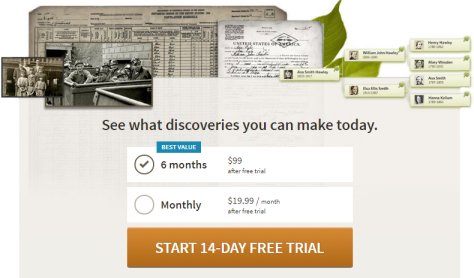 Revolutionary War. Full copies of the Compiled Military Service Records for CT, DE, GA, MD, MA, NH, NJ, NY, NC, PA, RI, SC, VT, VA, and Continental Troops. (This database often doesn’t list the local militia, as most of the men listed were part of the continental line. Researchers search by keyword or location.)
Revolutionary War. Full copies of the Compiled Military Service Records for CT, DE, GA, MD, MA, NH, NJ, NY, NC, PA, RI, SC, VT, VA, and Continental Troops. (This database often doesn’t list the local militia, as most of the men listed were part of the continental line. Researchers search by keyword or location.)- Old Wars. An index and full images of the Compiled Military Service Records of those men who served after the Revolutionary War and before the War of 1812, covering the years of 1784-1811.
- War of 1812. Abstracted lists of names, state, and military units from the Compiled Service Records (no images).
- Indian Wars: Database with images for Florida: includes the Florida Wars, Second Creek War, and the Third Seminole War from 1835-1858.
- Mexican War. Full copies of the CMSR for MS, PA, TN, TX, and the Mormon Battalion.
- Civil War: Indexes to Union Compiled Military Service Records and Confederate Compiled Military Service Records. An additional set of Service Records comes from units that were raised by the Confederate Government and not from any of the states that comprised the Confederacy; you can view the images and search by military unit.
- Spanish American War. Compiled Military Service Record Indexes cover the same geographical areas as on Fold3. Full copies of CMSR are online for Florida.
Free Compiled Military Service Records at FamilySearch.org:
FamilySearch has fewer Compiled Military Service Records that include images. One of the major collections includes the Revolutionary War CMSR’s that when searched here, the images provide a direct link to Fold3.
Most of the other major war periods are microfilmed and available at the Family History Library in Salt Lake City, Utah. With online access through both Fold3 and Ancestry provided on the computers in the library, though, accessing the film is less desirable. Click here to learn more about changes in microfilm lending at the Family History Library.

Michael Strauss contributes the Military Minutes segment on Lisa Louise Cooke’s Genealogy Gems Podcast. In the recently-published Episode 211, he profiles the 20th-century replacement for Compiled Military Service Records: the Official Military Personnel File. Click here and listen for free!
Disclosure: This article contains affiliate links and Genealogy Gems will be compensated if you make a purchase after clicking on these links (at no additional cost to you). Thank you for supporting the free Genealogy Gems podcast and blog!
by mbarker | May 30, 2018 | 01 What's New, Archives, Mobile
A new “Archivist in a Backpack” project to support community archiving offers genealogists a great idea: a portable archiving kit for on-the-go genealogy research and preservation projects. The Archive Lady Melissa Barker explains the initiative and offers...
by Lisa Cooke | Oct 10, 2016 | 01 What's New, Google
Using Google Books for genealogy is a successful tool to many. A Gem’s reader shares the remarkable story she uncovered using the tips for using Google Books she learned from a recent Genealogy Gems Premium podcast.

From Genealogy Gems Premium member:
“Hi Lisa,
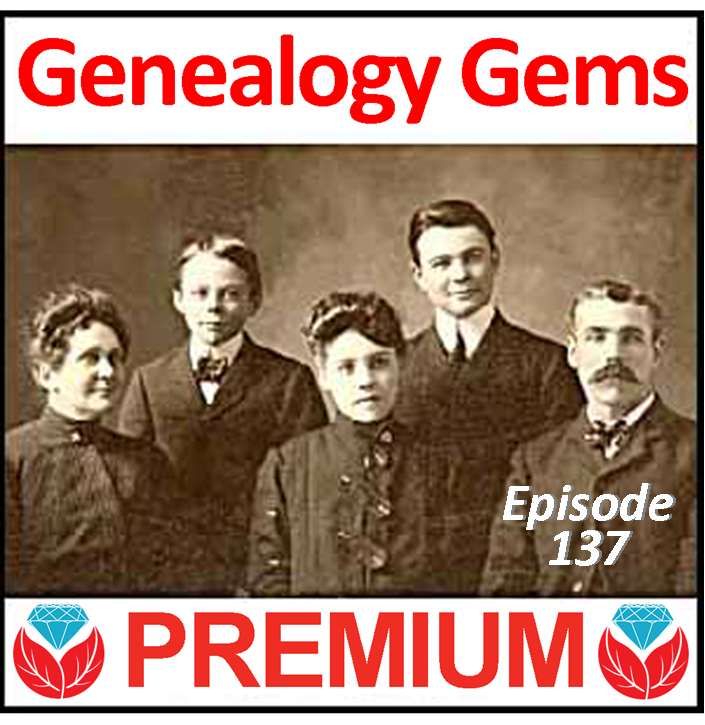 I was just listening to the newest Premium podcast concerning filtering the lists on Google Books (Premium episode 137). I would like to relay my story for using your hints and tips on Google.
I was just listening to the newest Premium podcast concerning filtering the lists on Google Books (Premium episode 137). I would like to relay my story for using your hints and tips on Google.
My great-grandfather was a Confederate soldier. At the age of 48, he married my great-grandmother and my grandmother was born the next year. I found much to my dismay, that he committed suicide when my grandmother was a few weeks old. It was stated that he had what would be described today as post-traumatic stress disorder, and the burning of the court house where he worked as a county clerk set off something. My Dad was born on what would have been my great-grandfather’s 90th birthday.
I have known for about 30 years that my great-grandfather wrote articles under a pen name. My aunt told me she had been told he wrote articles about the scenery in southern Utah where he lived. I searched and searched and never found any of his articles. Then, I had a breakthrough. I found the pen name by using several tips you mentioned for using Google. The pen name was Lock Melone. It was spelled differently than I had been told.
It turns out, he was a very well-known humorist. One of his stories appears in a publication alongside an article by Mark Twain. (He wrote articles in the 1870s and 1880s.)
Now, back to your tips on Google. I was Googling, checking all the old newspapers I could find to collect his writings. One of the sources continually mentioned in Google Books was a literary magazine called The Californian. These were not all free on Google, but I was not to be deterred after all these years! I used the basic information and time frames listed in Google Books and looked at WorldCat. That led me to e-books and to some of the holdings in universities around the country.
As of today, I have found 69 of his articles! They have made an ancestor who I thought had a rough life with a tragic end, a new person, full of life and laughter! I am sure his stories are based on events that occurred during his “real life” adventures. He lived life to the fullest, traveling a great deal, and saw the world through a light heart.
I am continuing to search for more articles and have begun to compile his writings to give to my children and cousins for a Christmas present this year (if I can figure out how to put it all together!) With my grandmother as his only child, I will have given his life to all his descendants, a very special chore on which I have worked on with great pleasure.
Thanks for the tips on Google and other sites you have given over the years.”
This Gems member is certainly on the right track in many ways. She figured out how to harness the power of Google to search for the proverbial needle in a haystack—not just her grandfather’s articles but articles written under a pseudonym! Good for her for using Google Books and WorldCat. That’s a great combination. You can learn more about using WorldCat for genealogy in my book How to Find Your Family History in Newspapers and in the Premium video Getting the Scoop Part 2: Tech Tools for Newspapers.
Follow-up Ideas for Using Google Books for Genealogy
Here are a few follow-up suggestions re lating to finding issues of a literary magazine or another scholarly publication like The Californian:
lating to finding issues of a literary magazine or another scholarly publication like The Californian:
First, turn to another powerful free tool in the Google toolbox: Google Scholar. It takes Google Books to the next level and you may hit on some things that Google Books may miss. Refer back to Premium Podcast 136 for a discussion of Google Scholar for genealogy, and Chapter 11 in my book The Genealogist’s Google Toolbox, Second Edition.
Second, remember that sometimes serial publications change names, or two different ones may have the same name. Wikipedia’s not the most expert source, but its article on The Californian says something you can follow up on. The Californian was published from 1880 to 1882, as a continuation of the earlier Overland Monthly which had stopped in 1875, and then in 1882 it switched back to its old name. This means you should look for both titles.
A third idea may be to check e-bay for back issues of old magazines and journals. Sometimes, it’s cheaper and easier to buy them than to try to borrow them through inter-library loan. E-bay does happen to have a CD version for sale of The Californian issues from 1880 to 1882. I talk more about finding family history items on e-bay in the Premium Podcast episodes 16, 76, and 131.
Lastly, don’t forget JSTOR. JSTOR is a shared digital library for scholarly journals and the like. It launched in 1995 to serve university and college libraries, running out of space to store old journal issues. Today, it includes over 2,300 journals and thousands of other materials. It’s even started including books. Over 50 million pages are digitized, with another 3 million being added every year.
The nice thing about JSTOR is that you don’t have to be affiliated with a major library to get access now. Individuals can register for free access allowing them to read some materials online. They offer free access to their Early Journal Content collection of scholarly content published before 1923 in the U.S. (and before 1870 in other parts of the world.) That collection alone has nearly a half million articles from over 200 journals.
Unfortunately in this case, JSTOR doesn’t have The Californian or Overland Monthly in its collections. But one can certainly use JSTOR to search for other journals. JSTOR is just a great resource for anyone to use when searching for historical articles, especially those you may come across in Google Scholar without the full article text.
Your Google Books for Genealogy Success Stories
It is so rewarding to hear your success stories in using Google Books for genealogy. Your stories inspire others. Please feel free to share your experiences in the comment section below.
Keep Reading: More Gems on Using Google Books for Genealogy Success
Free Video: Google Books Image Search for Genealogy and Family History
Google Scholar for Genealogy? Here’s Why to Try It
by Lacey Cooke | Jun 7, 2019 | 01 What's New, Records & databases, Swedish |
This week’s Friday records post is all about Swedish genealogy! Findmypast has added 12 million Swedish records to their international collection, and we’ll show you other resources for accessing similar records. We’ll also highlight some past unique collections for Sweden, and you can explore expert research tips from a professional genealogist.
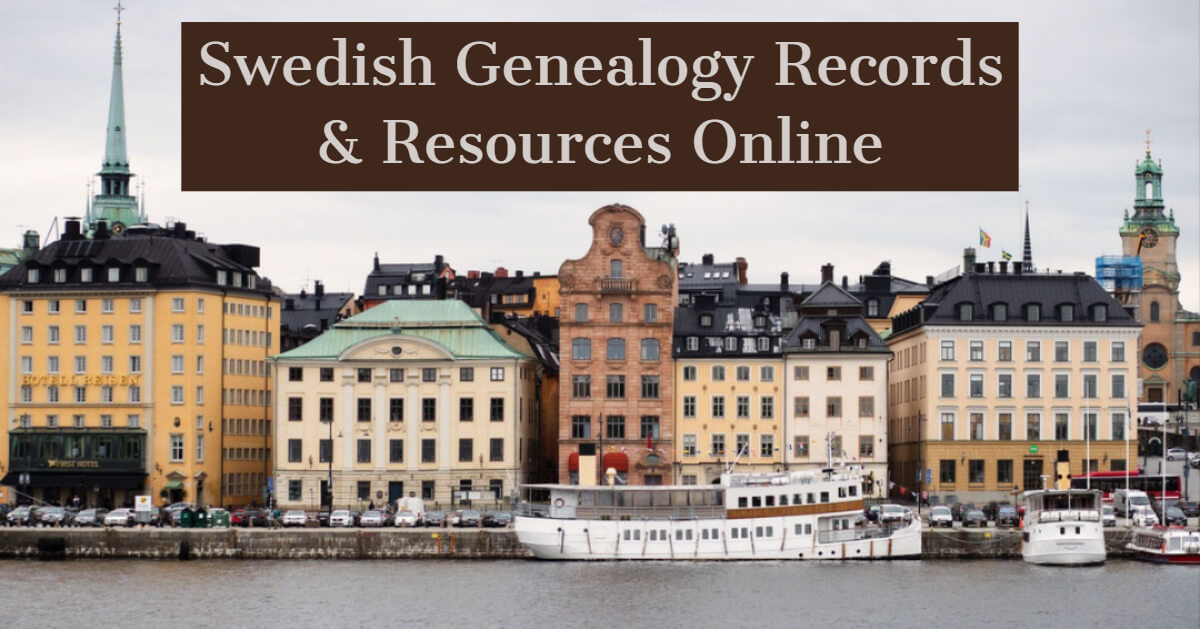
Featured: Swedish Genealogy Records Online
June 6 is the National Day of Sweden, which honors two historical events: Gustav Vasa being elected king on June 6, 1523, and the adoption of a new constitution on June 6, 1809. After decades of discussion, the Swedish parliament finally voted to make June 6 a public holiday. And we can’t think of a better way to observe than to spend time researching your Swedish ancestors!
As Findmypast continues to grow their international records database, they’ve highlighted the recent addition of Swedish records to their collection. Over 12 million Swedish baptisms, marriages, and burials are now dating back to 1611 are now available to search on Findmypast. These records will also generate hints against your Findmypast family tree.
Their Swedish collection consist of the following indexes:
If you’re a Findmypast subscriber, head over there now to explore these indexed records. If you’re not a Findmypast subscriber, you can explore select Swedish baptisms, burials, and marriages at Ancestry.com. You can also find select Swedish baptisms, burials, and marriages at FamilySearch.org for free.
Unique Swedish Genealogy Resources
Swedish Newspapers. A couple of years back we highlighted the Minnesota Historical Society’s collection of Swedish-American newspapers. They are available through an online portal. Users can explore more than 300,000 pages from 28 different Swedish-American newspaper titles published across the U.S. between 1859 and 2007. The portal is available in Swedish and English and includes a keyword search.
Biographies of notable Swedish women. The Chicago Evening Post reported on a new online biographical dictionary of women in Swedish history. The site itself is Svenskt kvinnobiografiskt lexicon (it does have an English-language home page). The home page encourages visitors to “Read up on 1,000 Swedish women from the Middle Ages to the present day. Use the search function to reveal what these women got up to, how they were educated, which organisations they belonged to, where they travelled, what they achieved, and much more. All of them contributed in a significant way to the development of Swedish society.” According to the Chicago Evening Post, the current collection of 1,000 biographical sketches will soon double (at least)
Expert Swedish Genealogy Research Tips
Swedish genealogy can be daunting. Many people avoid Swedish research because they don’t speak the language and because the names change every generation–like from Ole Olsson to Ole Nilsson to Nils Pehrrson. Despite these barriers, Swedish research can be relatively simple, fun, and successful! In a special guest article, Paul Woodbury, a Senior Genealogist with Legacy Tree Genealogists, shares the following 5 things to keep in mind when researching your Swedish ancestors:
- You can “read” many records without reading Swedish.
- Family events are summarized in Swedish clerical examinations.
- Many Swedish records cross-reference each other.
- You can trouble-shoot record gaps.
- There are some excellent Swedish indexes and databases online.
Paul covers these 5 points in-depth in this special article. Click here to read it now!
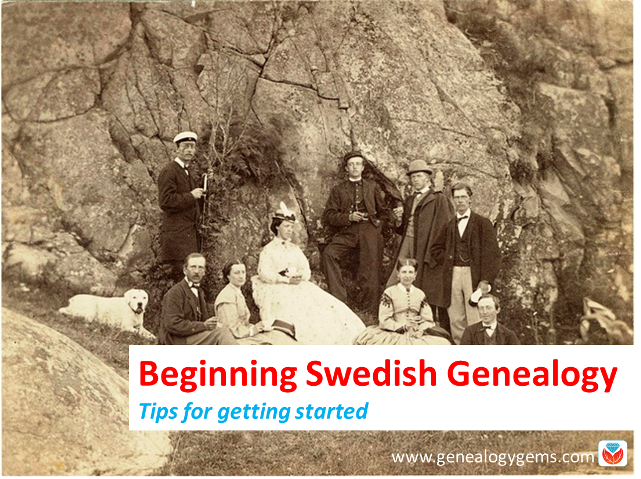

About the Author: Lisa Louise Cooke is the producer and host of the Genealogy Gems Podcast, an online genealogy audio show and app. She is the author of the books The Genealogist’s Google Toolbox, Mobile Genealogy, How to Find Your Family History in Newspapers, and the Google Earth for Genealogy video series. She is an international keynote speaker and the Vice President of the Genealogical Speakers Guild.
Disclosure: This article contains affiliate links and Genealogy Gems will be compensated if you make a purchase after clicking on these links (at no additional cost to you). Thank you for supporting Genealogy Gems!

 ested I go to the local public library just down the street.
ested I go to the local public library just down the street.













 I was just listening to the newest Premium podcast concerning filtering the lists on Google Books (
I was just listening to the newest Premium podcast concerning filtering the lists on Google Books ( lating to finding issues of a literary magazine or another scholarly publication like The Californian:
lating to finding issues of a literary magazine or another scholarly publication like The Californian:

